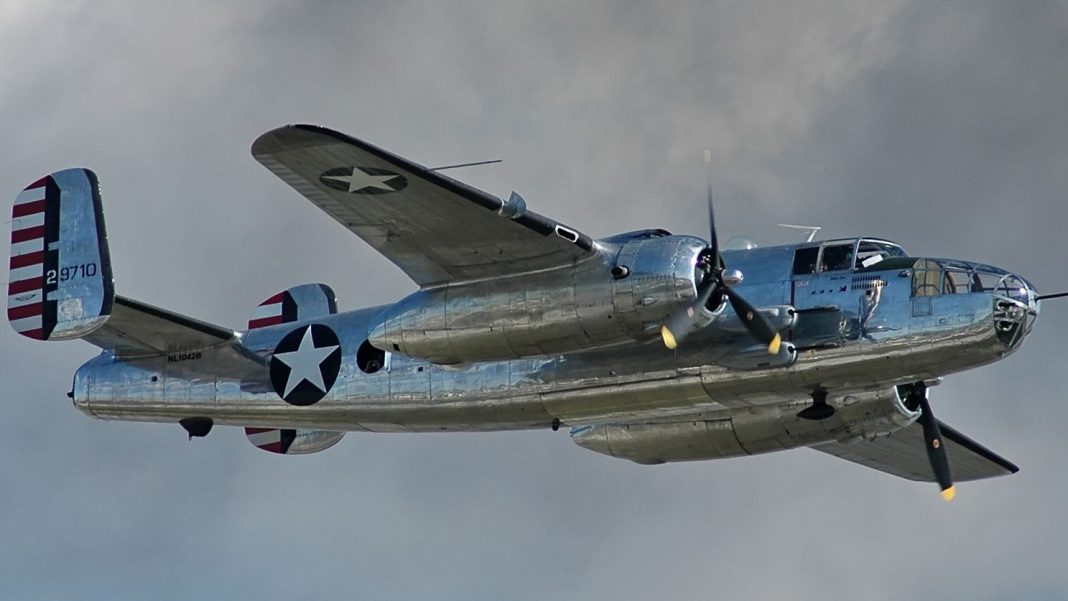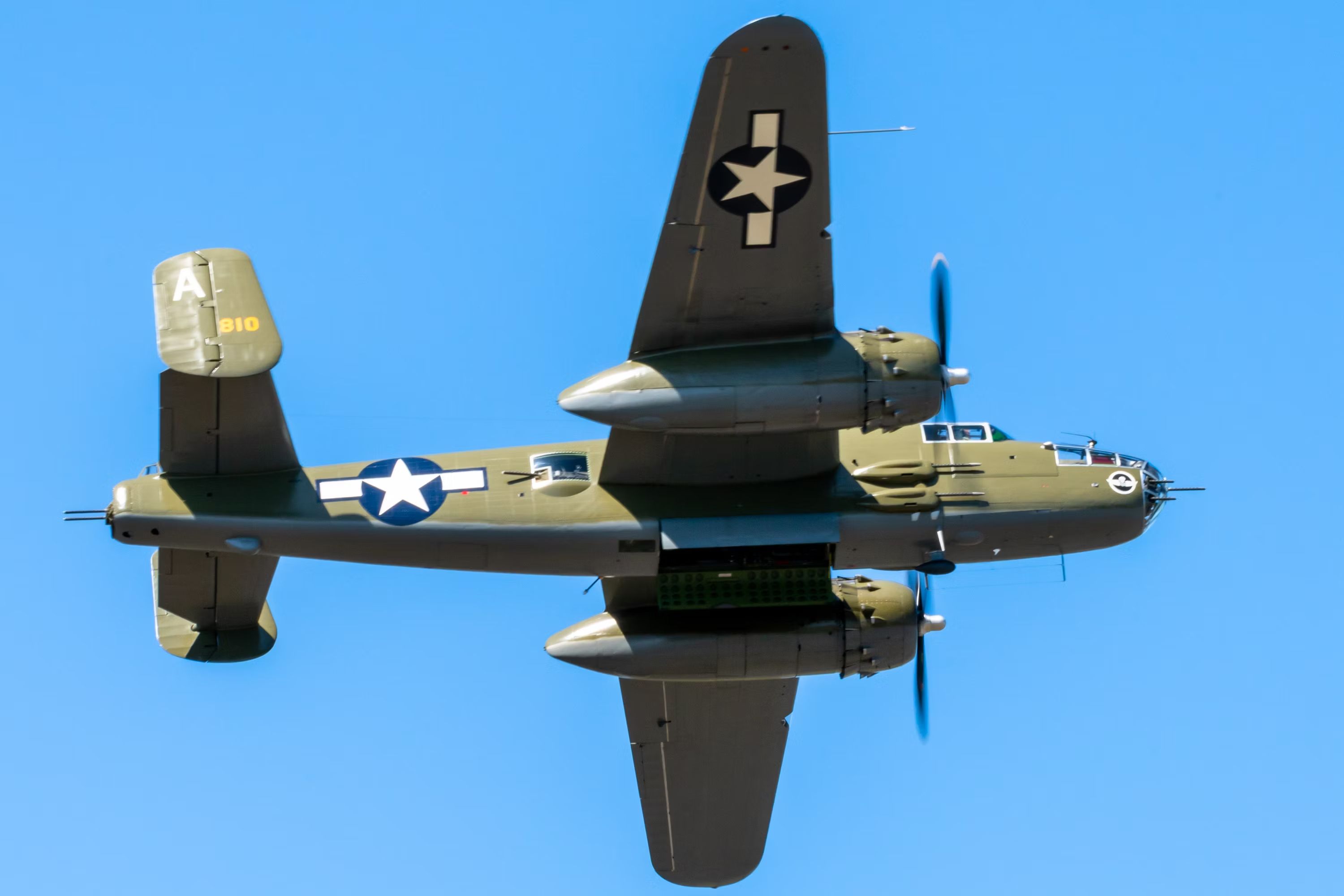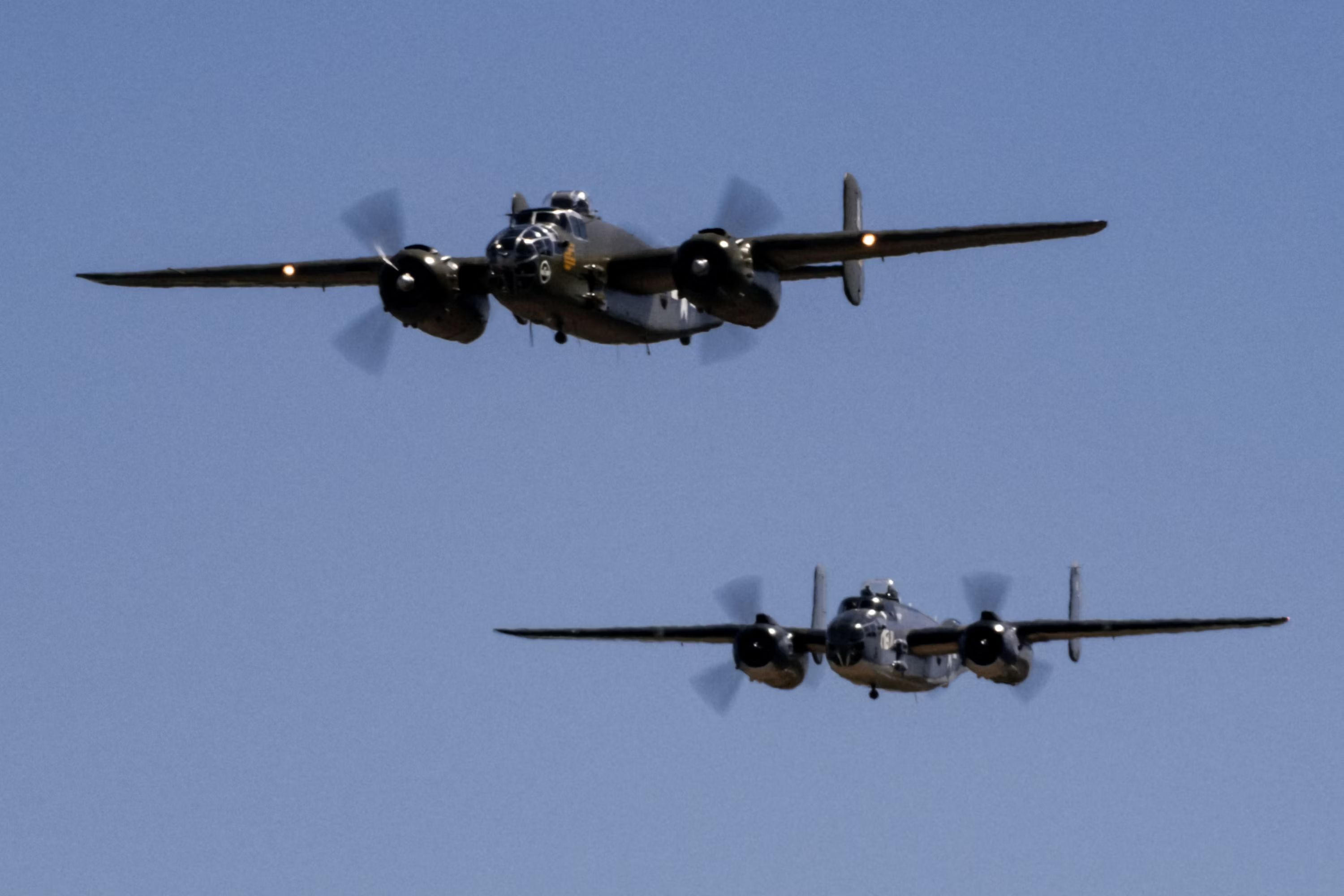Summary
- The B-25 Mitchell bomber is named after Air Force Colonel William Lendrum Mitchell, the “Father of the US Air Force.”
- The B-25 was a perfectly configured medium bomber with powerful engines and a stable airframe, making it light, maneuverable, and versatile in combat.
- Despite its lower service ceiling, the B-25 was faster and more nimble than other US bombers of its time, making it effective at outmaneuvering interceptors like the Mitsubishi A6M Zero. The B-25 is famous for leading the Doolittle Raid on Tokyo.
The North American B-25 Mitchell was first introduced by the US Air Force in 1941, and thousands would go on to serve during the Second World War. Later on, the aircraft would serve with Air Forces across the globe, including the Royal Air Force, the Soviet Air Force, and the Indonesian Air Force, which was the last operator to fly the twin-engine aircraft, retiring the Mitchell only in 1979.
The Mitchell has a fascinating backstory and a unique operational history. As a true medium bomber, the aircraft bridged the responsibilities and mission capabilities of large strategic bombers like the Boeing B-17 Flying Fortress and smaller fighter-bombers. In this article, we will take a deeper look at the B-25 Mitchell and explore five cool facts about the bomber you may not have known.
1 The plane is named after Billy Mitchell
He was known as the “Father of the US Air Force”
|
Bomber: |
Nickname: |
|
B-17 |
Flying Fortress |
|
B-24 |
Liberator |
|
B-25 |
Mitchell |
|
B-29 |
Superfortress |
The majority of America’s World War II bombers had nicknames that evoked one of two things: security or power. Initially, the B-25 seems like a slight exception to this rule, as one of America’s only bombers during the Second World War to be named after an individual. In this case, however, the aircraft’s nickname is a direct reference to the legendary Air Force Colonel William Lendrum Mitchell.
Photo: Joe Kunzler | Simple Flying
Mitchell was a noteworthy pioneer in US military aviation, serving in France during the First World War and eventually rising to command all aerial operations in the European nation. He pioneered the idea of using bombers to sink battleships and oversaw some of the first bombing raids on naval vessels. Due to his incredible influence on aerial warfare, he has been dubbed the “Father of the US Air Force.”
2 A perfectly configured medium bomber
Two powerful engines designed for power and an airframe designed for stability
|
Wingspan: |
67 ft 7 in (20.6 m) |
|
Length: |
52 ft 11 in (16.13 m) |
|
Powerplant: |
2 x Wright R-2600-92 Twin Cyclone 14-cylinder radial piston engines |
|
Height: |
16 ft 4 in (4.98 m) |
The aircraft was smaller than most of the heavy bombers of the era, but despite this was able to operate efficiently on account of a large wingspan and powerful engines. Crewed by five men, the aircraft was designed to be light, easily maneuverable, and versatile in combat.
The bomber’s specifications played a key role in defining the plane’s operational capabilities. Notably, the aircraft’s relatively lightweight, large wings and powerful engines allowed the plane to take off from the decks of aircraft carriers, essential in the plane’s mission capabilities in the Pacific theater where air bases were too sparse to make the B-25’s relatively limited range effective.
3 Faster than the other US bombers
Unable to outclimb, however
|
Cruising Speed: |
230 mph (370 km/h) |
|
Maximum Speed: |
272 mph (438 km/h) |
|
Service Ceiling: |
24,200 ft (7,400 m) |
The B-25 Mitchell was far more nimble than other bombers of the time, able to easily fly faster than the strategic B-17 Flying Fortress. Where the aircraft lagged behind its contemporaries was its service ceiling, however, as most bombers of the era could easily climb beyond 30,000 feet. Nonetheless, the B-25 was far more effective at outmaneuvering interceptors than many of its contemporaries.
Photo: Joe Kunzler | Simple Flying
In the Pacific theater, one of the interceptors the B-25 most commonly encountered was the Mitsubishi A6M Zero, a nimble light fighter that could fly both faster and higher than the B-25 Mitchell. Nonetheless, the aircraft survived many of its encounters with the Zero, most of the time thanks to powerful escort fighters such as the Curtiss P-40 Warhawk.
4 The B-25’s most famous mission
It led the famous Doolittle Raid on Tokyo
|
Aircraft involved: |
16 B-25 Mitchell Bombers |
|
Servicemen involved: |
52 officers and 28 enlisted men |
|
Damage: |
5 sailors were captured, 50 killed, 5 patrol boats sunk, and 3 aircraft shot down |
The first United States aerial offense against the Japanese capital, Tokyo, was known as the Doolittle Raid and took place on 18 April 1942 by the US Air Force. This raid killed roughly 50 people on the ground and severely damaged a variety of Japanese industrial institutions. According to Japanese accounts, although the raid only led to limited loss of life, the severe loss of infrastructure dealt major psychological damage to Japanese forces.
The raid was widely acknowledged to be a retaliatory offensive in response to the Japanese attack on Pearl Harbor. The attack involved 16 B-25 Mitchell bombers launching from the US Navy aircraft carrier the USS Hornet in the Pacific Ocean. The twin-engined planes spent a few hours in the air before engaging their targets. Ultimately, all aircraft were lost in the raid.
5 An incredibly durable aircraft
The plane could sustain significant damage and is durable over time
|
Number built: |
9,816 |
|
Number still airworthy: |
45 |
Throughout its operational history, the B-25 was renowned for its durability in battle, and its ability to sustain incredible levels of damage. So well known for its durability was the B-25 that the 321st Bomb Group nicknamed the plane “Patches.”
Uniquely, 45 B-25s remain airworthy today, 17 of which took flight in 2010 to commemorate the Doolittle Raid. Most World War II bombers have far fewer airworthy units remaining. The B-29, for instance, only has two.
Have you ever seen a B-25 in person? What do you think of the aircraft?
[ad_2]
Source link




